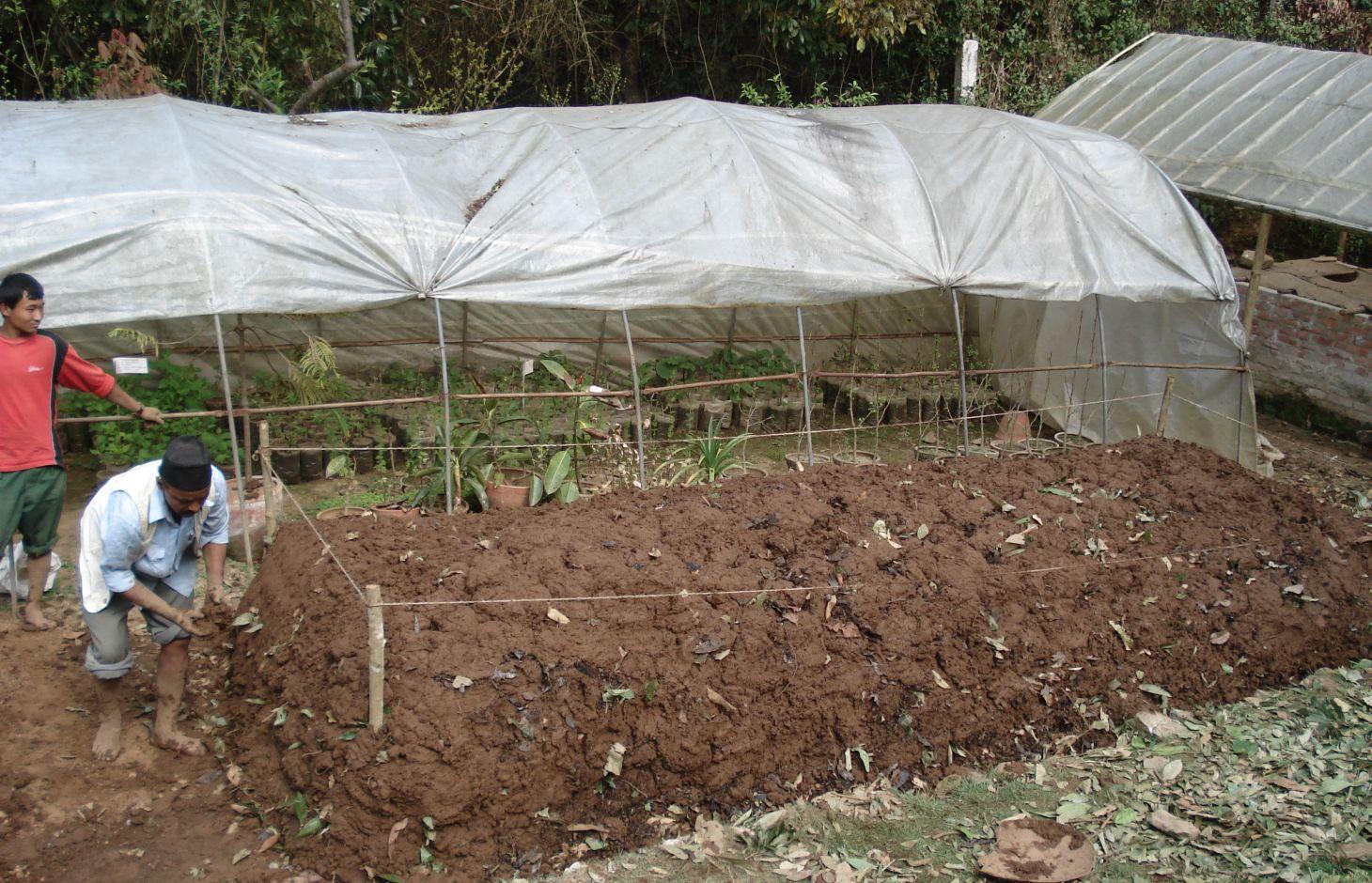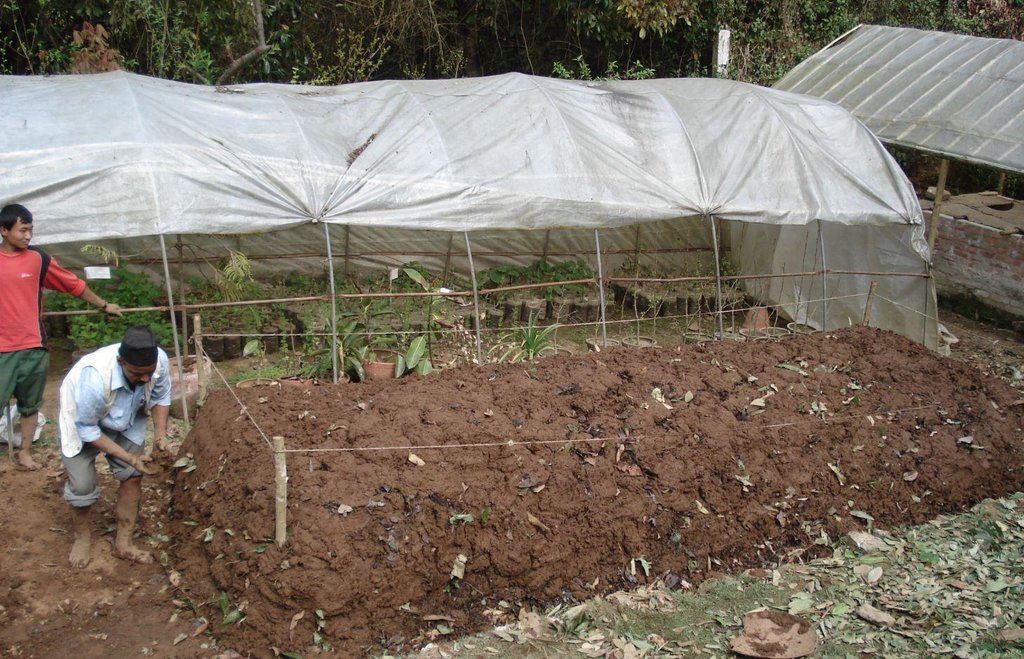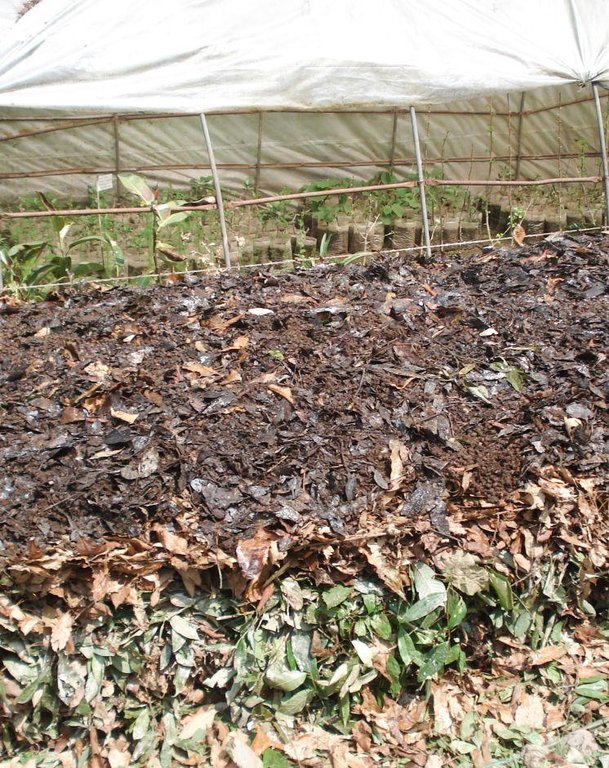Biodynamic composting [尼泊尔]
- 创建:
- 更新:
- 编制者: Shreedip Sigdel
- 编辑者: –
- 审查者: David Streiff, Alexandra Gavilano
Jaibic Mal Banune Takika (Nepali) (Main Contributor: Samden Sherpa, ICIMOD)
technologies_1682 - 尼泊尔
查看章节
全部展开 全部收起1. 一般信息
1.2 参与该技术评估和文件编制的资源人员和机构的联系方式
SLM专业人员:
Sherpa Samden L
ICIMOD
尼泊尔
有助于对技术进行记录/评估的机构名称(如相关)
ICIMOD International Centre for Integrated Mountain Development (ICIMOD) - 尼泊尔1.3 关于使用通过WOCAT记录的数据的条件
编制者和关键资源人员接受有关使用通过WOCAT记录数据的条件。:
是
2. SLM技术的说明
2.1 技术简介
技术定义:
A faster and more effective way to produce high quality compost in large quantities by surface composting using dry and green farm biomass piled in a heap.
2.2 技术的详细说明
说明:
Biodynamic denotes a method of organic farming that emphasizes a holistic understanding of the interrelationships between soil, plants, and animals in a self-sustaining system. It excludes the use of artificial chemicals and stresses the importance of integrating farm animals, the cultivation of crops, and caring for the land. Fermented herbal and mineral preparations are used as compost additives and field sprays.
Purpose of the Technology: Biodynamic composting is an inexpensive means of producing a large amount of compost within a relatively short time compared to other methods. It is ideal for farmers who require large amounts of compost, such as for orchards; or when several households get together to produce and share compost. This type of composting also helps to store soil carbon, assists irrigation practices that keep fields alternatively moist and dry, works to decrease the number of soil pests, and reduces methane emission. This practice not only enhances agricultural production as an on-site benefit to the land users but also contributes to the off-site benefits enjoyed by downstream land users, since it helps to reduce sedimentation and increases water availability.
Establishment / maintenance activities and inputs: The biodynamic compost is prepared as a surface heap rather than in a traditional pit. The heap is built on a flat, dry site away from shade trees and other elements that would promote water logging. The farmer marks out a rectangular plot of land according to his needs and places a set of logs or PVC pipes lengthwise in the middle of the rectangle to facilitate air circulation and help aerate the pile. Alternating layers of dry and green biomass are added on top. Rock phosphate and crushed slaked lime are added to the middle layers to enhance decomposition and to supplement the mineral content. Once the layering is complete, the pile is sealed using a paste made from soil and cow dung. Over the ensuing two months, the pile is watered weekly (through holes made in the plaster layer which are then resealed) and is monitored; any cracks that appear in the external plaster are sealed. At the end of this time, the compost is tested to check if it is ready by taking samples from a few different locations in the heap. When a crushed sample smells like forest soil, it indicates that the degradation is 80% complete and that the compost is ready to use.
2.3 技术照片
2.5 已应用该技术的、本评估所涵盖的国家/地区/地点
国家:
尼泊尔
有关地点的进一步说明:
Lalitpur District
具体说明该技术的分布:
- 适用于特定场所/集中在较小区域
注释:
Demonstration Plot at ICIMOD Knowledge Park
2.6 实施日期
如果不知道确切的年份,请说明大概的日期:
- 10-50年前
2.7 技术介绍
详细说明该技术是如何引入的:
- 在实验/研究期间
3. SLM技术的分类
3.1 该技术的主要目的
- 减少、预防、恢复土地退化
- Access to fertilizer
3.2 应用该技术的当前土地利用类型

农田
- 一年一作

森林/林地
产品和服务:
- 薪材
- fodder
注释:
Major land use problems (compiler’s opinion): Crop productivity is limited by poor soil fertility, intense cropping, and a scarcity of irrigation water. Farmers in the hills notice a marked decrease in the health of their crops and degraded soil conditions when chemical fertilizers are overused. Biodynamic composting is a low input response to this problem.
Forest products and services: fuelwood
Other forest products and services: fodder
Constraints of Scrubland
3.5 该技术所属的SLM组
- 土壤肥力综合管理
3.6 包含该技术的可持续土地管理措施

管理措施
- M5:物种组成的控制/变化
3.7 该技术强调的主要土地退化类型

化学性土壤退化
- Cn:肥力下降和有机质含量下降(非侵蚀所致)
3.8 防止、减少或恢复土地退化
具体数量名该技术与土地退化有关的目标:
- 防止土地退化
4. 技术规范、实施活动、投入和成本
4.1 该技术的技术图纸
技术规范(与技术图纸相关):
Layering of the different materials in a biodynamic compost heap
Technical knowledge required for field staff / advisors: moderate
Technical knowledge required for land users: moderate (technicians as well)
Main technical functions: increase in organic matter, Increase Soil fertility and Productivity, Improve Physical condition of the soil
Secondary technical functions: increase of infiltration, increase / maintain water stored in soil, Improve the physical properties of the soil
Other type of management: Improve Compost Quality
作者:
Layering of the different materials in a biodynamic compost heap
4.2 有关投入和成本计算的一般信息
具体说明成本和投入是如何计算的:
- 每个技术单元
指定单位:
compost heap
其它/国家货币(具体说明):
NPR
如相关,注明美元与当地货币的汇率(例如1美元=79.9巴西雷亚尔):1美元=:
71.0
4.3 技术建立活动
| 活动 | 时间(季度) | |
|---|---|---|
| 1. | include cow dung, crushed lime, rock phosphate (or bone meal), and dry and green farm matter. The compost heap is assembled in less than one day and the compost is ready to use within two months (under weather and temperature conditions similar to those at the ICIMOD Knowledge Park).Note: If rock phosphate is not available, crushed stone dust can besubstituted. | 2 month |
4.4 技术建立所需要的费用和投入
| 对投入进行具体说明 | 单位 | 数量 | 单位成本 | 每项投入的总成本 | 土地使用者承担的成本% | |
|---|---|---|---|---|---|---|
| 劳动力 | Labour | unit | 1.0 | 80.0 | 80.0 | |
| 设备 | Shovel, chopping machine, bucket, bamboo, rope | unit | 1.0 | 20.0 | 20.0 | |
| 施工材料 | cow dung | kg/unit | 300.0 | 0.1 | 30.0 | |
| 施工材料 | lime and rock phosphate | kg/unit | 25.0 | 0.8 | 20.0 | |
| 技术建立所需总成本 | 150.0 | |||||
| 技术建立总成本,美元 | 2.11 | |||||
4.5 维护/经常性活动
| 活动 | 时间/频率 | |
|---|---|---|
| 1. | The compost heap is punctured weekly in order to add water; after watering, the punctures are resealed using cow dung. | weekly |
4.6 维护/经常性活动所需要的费用和投入(每年)
| 对投入进行具体说明 | 单位 | 数量 | 单位成本 | 每项投入的总成本 | 土地使用者承担的成本% | |
|---|---|---|---|---|---|---|
| 劳动力 | Labour | unit | 1.0 | 25.0 | 25.0 | |
| 施工材料 | Compost / manure | unit | 1.0 | 10.0 | 10.0 | |
| 技术维护所需总成本 | 35.0 | |||||
| 技术维护总成本,美元 | 0.49 | |||||
4.7 影响成本的最重要因素
描述影响成本的最决定性因素:
All costs and amounts are rough estimates by the technicians and authors. Exchange rate USD 1 = NPR 71 in May 2011. This was a demonstration project conducted by ICIMOD.
5. 自然和人文环境
5.1 气候
年降雨量
- < 250毫米
- 251-500毫米
- 501-750毫米
- 751-1,000毫米
- 1,001-1,500毫米
- 1,501-2,000毫米
- 2,001-3,000毫米
- 3,001-4,000毫米
- > 4,000毫米
农业气候带
- 半湿润
Thermal climate class: temperate
5.2 地形
平均坡度:
- 水平(0-2%)
- 缓降(3-5%)
- 平缓(6-10%)
- 滚坡(11-15%)
- 崎岖(16-30%)
- 陡峭(31-60%)
- 非常陡峭(>60%)
地形:
- 高原/平原
- 山脊
- 山坡
- 山地斜坡
- 麓坡
- 谷底
垂直分布带:
- 0-100 m a.s.l.
- 101-500 m a.s.l.
- 501-1,000 m a.s.l.
- 1,001-1,500 m a.s.l.
- 1,501-2,000 m a.s.l.
- 2,001-2,500 m a.s.l.
- 2,501-3,000 m a.s.l.
- 3,001-4,000 m a.s.l.
- > 4,000 m a.s.l.
5.3 土壤
平均土层深度:
- 非常浅(0-20厘米)
- 浅(21-50厘米)
- 中等深度(51-80厘米)
- 深(81-120厘米)
- 非常深(> 120厘米)
土壤质地(表土):
- 中粒(壤土、粉土)
表土有机质:
- 高(>3%)
如有可能,附上完整的土壤描述或具体说明可用的信息,例如土壤类型、土壤酸碱度、阳离子交换能力、氮、盐度等。:
Soil fertility is medium
Soil drainage / infiltration is poor
Soil water storage capacity is medium
5.4 水资源可用性和质量
地下水位表:
< 5米
地表水的可用性:
好
水质(未处理):
仅供农业使用(灌溉)
关于水质和水量的注释和进一步规范:
Water quality (untreated): Also good drinking water
5.5 生物多样性
物种多样性:
- 高
关于生物多样性的注释和进一步规范:
695 species of flora and 230 species of fauna have been documented within the Park's 30 ha area
5.6 应用该技术的土地使用者的特征
生产系统的市场定位:
- 混合(生计/商业)
非农收入:
- > 收入的50%
相对财富水平:
- 贫瘠
个人或集体:
- 员工(公司、政府)
机械化水平:
- 手工作业
- 畜力牵引
性别:
- 女人
- 男人
说明土地使用者的其他有关特征:
Land users applying the Technology are mainly common / average land users
Population density: < 10 persons/km2
(Neighbouring communities are poor).
Off-farm income specification: >50% of all households around the demonstration site have off-farm income
Market orientation of production system: In the vicinity of the demonstration site
5.7 应用该技术的土地使用者使用的平均土地面积
- < 0.5 公顷
- 0.5-1 公顷
- 1-2 公顷
- 2-5公顷
- 5-15公顷
- 15-50公顷
- 50-100公顷
- 100-500公顷
- 500-1,000公顷
- 1,000-10,000公顷
- > 10,000公顷
这被认为是小规模、中规模还是大规模的(参照当地实际情况)?:
- 小规模的
5.8 土地所有权、土地使用权和水使用权
- government
土地使用权:
- 社区(有组织)
用水权:
- 社区(有组织)
5.9 进入服务和基础设施的通道
道路和交通:
- 贫瘠
- 适度的
- 好
labour available:
- 贫瘠
- 适度的
- 好
6. 影响和结论性说明
6.1 该技术的现场影响
社会经济效应
生产
作物生产
收入和成本
农业投入费用
注释/具体说明:
Reduce expenses for purchasing chemical fertilizers
农业收入
社会文化影响
SLM/土地退化知识
注释/具体说明:
Improve knowledge on bio dynamic composting
Improve knowledge on soil conservation and soil fertility
livelihood and human well-being
注释/具体说明:
Biodynamic composting is an advanced farming system that is gaining popularity because it improves the quality of crops and the health of the soil. The use of biodynamic compost improves soil fertility; increases agricultural production, and contributes to improved livelihoods.
生态影响
土壤
土壤有机物/地下C
其它生态影响
Better compost encourages farmers to diversify crops to include mixed farming
Use of chemical fertilizers
6.2 该技术的场外影响已经显现
Environmentally friendly: keeps village cleaner by recycling waste matter
6.4 成本效益分析
技术收益与技术建立成本相比如何(从土地使用者的角度看)?
短期回报:
积极
长期回报:
积极
技术收益与技术维护成本/经常性成本相比如何(从土地使用者的角度看)?
短期回报:
积极
长期回报:
积极
注释:
The land user enjoys both short and long-term benefits; in the short term there is a reduced need for costly chemical/mineral fertilizers and in the long term the health of the soil improves. Locally available dry and green biomass can be used for making biodynamic compost. The only extra costs arise from the need for lime, rock phosphate, and labour.
6.5 技术采用
- 单例/实验
如若可行,进行量化(住户数量和/或覆盖面积):
Experiment
在所有采用这项技术的人当中,有多少人是自发的,即未获得任何物质奖励/付款?:
- 0-10%
注释:
There is a moderate trend towards spontaneous adoption of the Technology
Comments on adoption trend: The biodynamic composting technique found a high rate of acceptance with orchard and vegetable farmers. ICIMOD provided farmers from the Godavari and Bishankhunarayan Village Development Committee areas with training on biodynamic composting. The farmers who need a large amount of compost, such as those who have orchards, have adopted the technique and are now producing the compost themselves.
Drivers for adoption:
• The technology is simple and inexpensive; it can be implemented using local materials.
• The biodynamic method is faster and produces more compost than traditional methods.
• The conditions promote complete decomposition and help to reduce the incidence of soil pests.
Constraints
• There is some initial investment cost in terms of the labour needed to collect biomass/soil and to construct the heap.
• This composting method is limited to farmers who keep livestock because fresh cow dung is needed.
6.7 该技术的优点/长处/机会
| 编制者或其他关键资源人员认为的长处/优势/机会 |
|---|
|
The main advantage of this method is that the composting process is completed within 60 days, whereas the traditional method requires more than 120 days. The biodynamic compost itself is very fine and decomposition takes place uniformly from top to bottom in the heap. How can they be sustained / enhanced? Share experiences with a wider audience and provide training to replicate the technology. |
|
The quality of biodynamic compost is better than that of traditionally prepared compost. The nutrient content of N, P, K, and organic matter, and the C/N ratio, are higher How can they be sustained / enhanced? Share experiences with a wider audience and provide training to replicate the technology. |
|
This method is suitable for producing large amounts of compost How can they be sustained / enhanced? As above |
|
Promotes organic production of desired crops and avoids the need for chemical fertilizers How can they be sustained / enhanced? As above |
6.8 技术的弱点/缺点/风险及其克服方法
| 编制者或其他关键资源人员认为的弱点/缺点/风险 | 如何克服它们? |
|---|---|
| Large amounts of biomass are not always available | Rice and wheat straw can also be used if forest biomass is not easily available. |
| Rock phosphate is not always available | crushed stone dust can be substituted. |
7. 参考和链接
7.1 信息的方法/来源
7.2 参考可用出版物
标题、作者、年份、ISBN:
Biodynamic farming and compost preparation, Diver, S, 1999
链接和模块
全部展开 全部收起链接
无链接
模块
无模块





